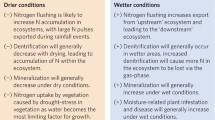Abstract
Overall, the greatest threats to Canadian and global biodiversity are associated with conversions of natural ecosystems to anthropogenic ones, and over-exploitation of biological resources. This circumstance does not, however, trivialize the importance of atmospheric influences. Although scientific understanding of the risks is incomplete, it is nevertheless clear that anthropogenic changes in atmospheric stressors are potentially damaging to biodiversity and other ecological values over medium- and longer-term scales. It is important that greater investments be made in support of longer-term monitoring and research designed to understand the effects of atmospheric and other environmental stressors on the biodiversity and structure and function of Canadian ecosystems.
Similar content being viewed by others
References
Anonymous: 1991, The State of Canada' s Environment, State of the Environment Reporting Organization, Environment Canada, Ottawa.
Anonymous: 1995, Canadian Biodiversity Strategy. Canada' s Response to the Convention on Biological Diversity, Biodiversity Convention Office, Environment Canada, Ottawa.
Baker, L. A. (principal author): 1990, Current Status of Surface Water Acid-base Chemistry, in: Acidic Deposition: State of Science and Technology, Vol. II, Aquatic Processes and Effects. pp. 9–1 to 9–367. Superintendent of Documents, U.S. Government Printing Office, Washington, D.C.
Beauchamp, S.: 1983, Planktonic Primary Production in Three Acid Stressed Lakes in Nova Scotia, Ph.D. Thesis, Dalhousie University, Halifax, N.S.
Blaustein, A. R., Hoffman, P. D., Hokit, D. G., Kiesecker, J. M., Walls, S. C. and Hays, J. D.: 1994, UV Repair and Resistance to Solar UV-B in Amphibian Eggs: A Link to Population Declines, Proc. Natl. Acad. Sci. USA 91, 1791–1795.
CEQ (Council on Environmental Quality): 1992, Environmental Quality. 22nd Annual Report, CEQ, Washington, D.C.
Dixit, S. S., Dixit, A. S. and Smol, J. P.: 1991, Multivariate environmental inferences based on diatom assemblages from Sudbury (Canada) lakes, Freshwater Biol. 26, 251–266.
Findlay, D. L. and Kasian, S. E. M.: 1986, Phytoplankton community responses to acidification of Lake 223, Experimental Lakes Area, northwestern Ontario, Water, Air, Soil Pollut. 30, 719–726.
Findlay, D. L. and Saesura, G.: 1980, Effects on phytoplankton biomass, succession, and composition in Lake 223 as a result of lowering pH levels from 7.0 to 5.6. Data from 1974 to 1979, Fisheries and Marine Service, Manuscript Rep. No. 1585. Department of Fisheries and Oceans, Winnipeg, Manitoba.
Freedman, B.: 1995, Environmental Ecology, 2nd ed. Academic Press, San Diego, CA.
Groombridge, B.: 1992, Global Biodiversity, World Conservation Monitoring Center, Chapman & Hall, London.
Harvey, H. H. and Lee, C.: 1982, Historical Fisheries Changes Related to Surface Water pH Changes in Canada, Proceedings of the International Symposium on Acid Rain and Fisheries, pp. 45–55.
Hendry, G. R., Yan, N. D. and Baumgartner, B.J.: 1980, Responses of freshwater plants and invertebrates to acidification, in: Restoration of Lakes and Inland Rivers, EPA 440/5-81/010, pp. 457–466. U.S. Environmental Protection Agency, Washington, D.C.
Kerekes, J. and Freedman, B.: 1988, Physical, chemical, and biological characteristics of three watersheds in Kejimkujik National Park, Nova Scotia, Arch. Environ. Contam. Toxicol. 18, 183–200.
Kerr, J. B. and McElvoy, C. T.: 1993, Evidence for upward trends in UV-B radiation linked to ozone depletion, Science 262, 1032–1035.
Munn, R. E. (ed.): 1996, Atmospheric Change and Biodiversity, Workshop Report, Inst. for Env. Studies, U. of Toronto, 71 pp.
Ostrovsky, M. L. and Duthie, H. C.: 1975, Primary productivity and phytoplankton of lakes on the eastern Canadian Shield, Verh.-Int. Verein. Theor. Angew. Limnol. 19, 732–738.
Rahel, F. J. and Magnuson, J. J.: 1983, Low pH and the absence of fish species in naturally acidic Wisconsin lakes: Inferences for cultural acidification, Can. J. Fish. Aquat. Sci. 40, 3–9.
Regier, H. A., Magnuson, J. J. and Coutant, C. C. (eds.): 1990, Proceedings: Symposium of Effects of Climate Change on Fish, Trans. Amer. Fish. Soc. 119, 173–389.
Reid, W., Barker, C. and Miller, K. (principal authors): 1992, Global Biodiversity Strategy, World Resources Institute, Washington, D.C.
Schindler, D. W., Curtis, P. J., Parker, B. R. and Stainton, M. P.: 1996, Consequences of climate warming and lake acidification for UV-B penetration in North American boreal lakes, Nature 379, 705–708.
Shearer, J.A., Fee, E. J., DeBruyn, E.R. and DeClercq, D.R.: 1987, Phytoplankton primary production and light attenuation responses to the experimental acidification of a small Canadian Shield lake, Can. J. Fish. Aquat. Sci. 44 Suppl. 1: 83–90.
Smith, J. B.: 1991, The potential impacts of climate changes on the Great Lakes, Bull. Amer.Meteorol. Soc. 72, 21–28.
Smol, J. P. and Glew, J. R.: 1992, Paleolimnology, in: Encyclopedia of Earth System Science, Vol. 3. pp. 551–564. Academic Press, San Diego, CA.
Soule, M. E.: 1991, Conservation: Tactics for a constant crisis, Science 253, 744–750.
Wilson, E. O. (ed.): 1988, Biodiversity, National Academy Press, Washington, D.C.
Yan, N. D. and Stokes, P. M.: 1978, Phytoplankton of an acidic lake, and its response to experimental alterations of pH, Environ. Conserv. 5: 93–100.
Author information
Authors and Affiliations
Rights and permissions
About this article
Cite this article
Freedman, B., Beauchamp, S. Implications of Atmospheric Change for Biodiversity of Aquatic Ecosystems in Canada. Environ Monit Assess 49, 271–280 (1998). https://doi.org/10.1023/A:1005851027038
Issue Date:
DOI: https://doi.org/10.1023/A:1005851027038




